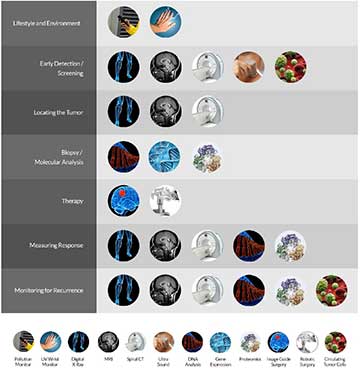
Examples, from the NPI whitepaper, of “technologies that could significantly improve outcomes and their effective employment in the cancer management spectrum.” [Image: National Photonics Initiative, “A Brighter Future: Eliminating Cancer through Adoption of New and Enhanced Technologies and a Transformed IT Health System,” 29 June 2016] [Enlarge image]
The U.S. National Cancer Institute (NCI) Cancer Moonshot—announced to considerable fanfare in January 2016 during President Barak Obama’s State of the Union address, and spearheaded by Vice President Joe Biden—aims at doubling the pace of progress in cancer research. The National Photonics Initiative (NPI), an alliance of industry, academia and government that works to promote, leverage and advance photonics technology and funding in the U.S., has now offered its own contribution to the Moonshot effort.
On 29 June, as part of a Cancer Moonshot Summit in Washington, D.C., NPI unveiled a whitepaper and road map [PDF] laying out its vision of how “new and enhanced technologies” can play a key part in achieving the Moonshot initiative’s objectives. And, not surprisingly, optical and photonic advances, especially in imaging, occupy an important place in that vision.
Ultimately, NPI’s hope is that the road map can provide guidance on leveraging and targeting some $3 billion in annual private investments in cancer research, particularly research focused on early detection and monitoring. “The good news,” noted Tom Baer, 2009 OSA President and current chair of the NPI Cancer Moonshot Task Force, “is that our country can make significant strides within the next five years by effectively utilizing existing technologies and leveraging new investments.”
Focus on early detection …
The Cancer Moonshot’s stated mission is to accelerate research progress in prevention, diagnosis, treatment and care of the disease, to allow “a decade worth of advances in five years.” While the new NPI road map touches on all of those research axes, it focuses particularly on technologies that can facilitate early detection and intervention at early stages, when the disease is easiest to fight.
The report thus calls for a boost in funding during the next five years for clinical studies using existing forms of minimally invasive imaging and molecular testing technologies, as well as for new, targeted quantitative imaging techniques, to allow for low-cost, precise early detection instruments and diagnostics that can quickly find their way into community-based care.
… And data
Another key recommendation of the report lies in the realm of medical “big data”—and, in particular, the need to develop an I.T. infrastructure that can support data-driven medicine. That’s important, NPI notes, not only to allow for rapid “dissemination of precision care” and high-data-volume images to improve patient outcomes, but also to grease the wheels of insurance reimbursement decisions and other logistics, and thereby make the entire system more cost efficient.
The NPI report points to the early impact of the International Early Lung Cancer Program (I-ELCAP) database, which has “enabled seminal research” and facilitated the development of national standards, as a success story for the role of good I.T. in the cancer fight. And it recommends that resources be allocated to develop a similar cloud-based, networked I.T. infrastructure across the cancer spectrum as a resource for the Moonshot initiative and beyond.
Public-private partnerships
The NPI report’s focus on early detection and strong I.T. comes amid a backdrop of the Moonshot’s broader internal goals: developing better treatments for patients; improving the distribution of those treatments; prevention and early diagnoses; addressing disparities of care; and more efficient use of big data.
“Technology is going to play a huge role in all five aspects,” noted Lauren Leiman, a staffer with the Office of the Vice President and the director of external affairs for the Moonshot program, in an NPI-sponsored webinar on 30 June, the day after the Cancer Moonshot Summit. Leiman also stressed the importance of developing public-private partnerships to attack the cancer hydra. NPI’s road map and involvement in the program, she said, is “an incredible example of what we’re doing really well with the Cancer Moonshot.”
